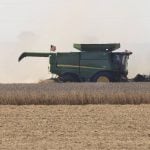WINNIPEG (Reuters) – Almost half of Canada’s prairie grain belt is considered dry enough to possibly force farmers to switch to grains over oilseeds.
The dryness may also affect the quality and yield of crops, crop analysts said in interviews.
“It’s a concern,” said Canadian Wheat Board director of weather and crop surveillance Paul Bullock. “Our immediate concern is in topsoil moisture in central Alberta and central Saskatchewan.”
An area east of Edmonton to Melfort, Sask., and south to Melita, Man., had less than 60 percent soil moisture, which means 60 percent of the maximum amount of water those types of soils can hold.
Read Also

Why feds imposed EV tariffs
Moe and Kinew have a fight on their hands when it comes to eliminating the EV tariff. Canada has to worry about pissing off the U.S. and Mexico and hundreds of thousands of auto workers.
Wheat and durum region
Seventy-five percent of Canada’s durum wheat is grown in southeastern Alberta and southwestern Saskatchewan and a large portion of spring wheat is grown in the affected areas.
Soil moisture was lower in February and without much snow since then, more farmers may switch to deeper-seeded cereals over shallower-seeded oilseeds, Bullock said.
“Now, seeding intentions will be less impacted by the winter precipitation but we’ll be highly dependent on summer rainfall.”
A lack of moisture during the growing season could cut into quality and yield, he added.
“Although the amount of moisture at planting is important for cereals and oilseeds, two-thirds of the moisture comes from the growing season and only one third is stored before seeding,” said Environment Canada soil scientist Rick Raddatz.














